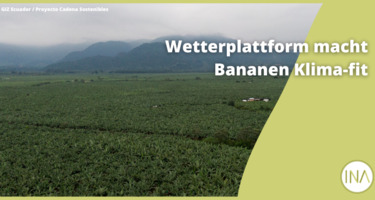Weather forecasts in banana cultivation
Half past nine in the morning in Germany: family breakfast finished, water bottle and banana packed as a snack, keys in hand, last look at the mobile phone: What does the weather app say? Is the thin jacket enough or would you prefer a thick one?
Have you already checked your weather app today? Maybe that's why you packed an umbrella instead of sunglasses? Now imagine that not only your daily outfit, but your livelihood depends on free access to weather data. This is the case for around 8,600 small and medium-scale peasant producers working in Ecuador's banana sector.
Due to climate change, Ecuador is experiencing a persistent rise in temperature, changes in the frequency and intensity of extreme events (droughts, floods), fluctuations in the water balance and the retreat of glaciers.
Bananas are thirsty
Banana production in Ecuador faces many challenges. Irrigation with water from nearby rivers or gravity systems is necessary. This is because bananas have a high water demand - both for production and for post-harvest processes such as washing.
Therefore, the availability of water in sufficient quantity and quality is of key importance. But the increasingly heavy rainfall increases the incidence of pest outbreaks, such as the red spot disease "Mancha Roja".
It is easy to see that controlling the environmental variables that influence crop development is essential for agricultural production. But such data, and the tools to obtain them, are expensive.
The solution: weather forecasts in banana production
To support the development of more climate-smart production systems, the Ecuadorian Association of Banana Exporters (AEBE) and the GIZ Global Project 'Sustainability and Value Creation in Agricultural Supply Chains' provide this information to smallholder banana farmers. Since the start of the project in 2021, six weather stations have already been installed on small and medium-sized banana plantations in the country's main production areas. The information gathered by the stations is analysed on a web platform, the Banana Observatory.
Producers receive up-to-date and freely accessible data on microclimate indicators, production and marketing on the website. At the same time, they help to identify the relationship between productivity indicators and microclimate indicators in the region by sharing data about their farm.
This enables the planning of production cycles, as well as the efficient use of water, fertilisers and pesticides. In concrete terms, this means that both the timing and the amount of irrigation can be determined more precisely with the help of the determined soil moisture. In addition, better nutrient management helps to significantly reduce nitrogen application and thus greenhouse gas emissions.
Overall, the data enables producers to achieve better crop management, higher productivity, less shrinkage and thus more fruit to export, and more resilient farming practices in the long term.
